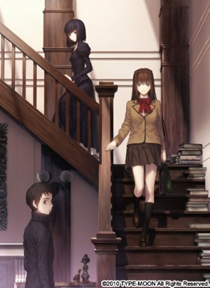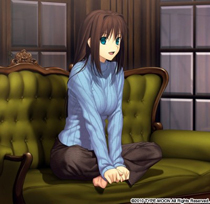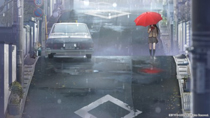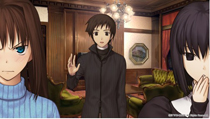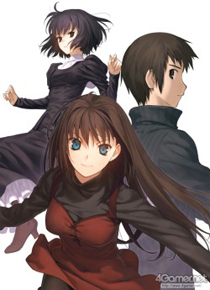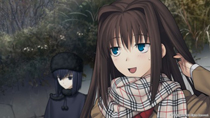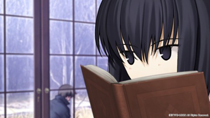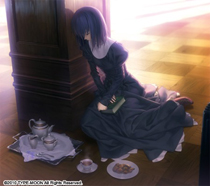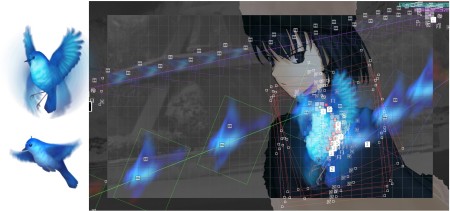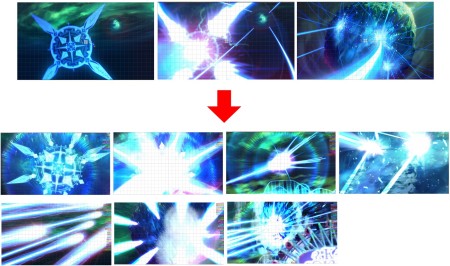4Gamer Interview with Mahoutsukai no Yoru Staff
Published on
4Gamer in May 2012
A translation of the interview from 4Gamer in 2012 with Nasu, Koyoma, and Tsukuri talking about their latest game, 「Mahoutsukai no Yoru」.
On April 12th, 2012, TYPE-MOON's newest work, 「Mahoutsukai no Yoru」, was released after eight years in development. The game is an adaptation from the original novel that became the basis of other TYPE-MOON games such as 「Tsukihime」, 「Kara no Kyoukai」, and 「Fate/stay night」.
The story takes place in Japan in the late 1980s during the economic bubble. Shizuki Soujuro, a boy from rural countryside who had just arrived in the city meets two mages, Aozaki Aoko and Kuonji Alice, living in the mansion on top of the hill. So begins the story of three people with different world views and values living together in the Kuonji household, and the various incidents that will take place.
While Nasu Kinoko is responsible for the script, the person in charge of art this time around is Koyama Hirokazu, while Tsukuri Monoji took on the role of director. In addition, the music is composed by Fukasawa Hideyuki and KATE, while supercell is responsible for the ED theme "Hoshi ga Matataku Konna Yoru ni."
Here, literary critic Sakagami Shusei talks to writer Nasu Kinoko, art director Koyama Hirokazu, and director Tsukuri Monoji about 「Mahoutsukai no Yoru」, its story, development, and what the future holds, revealing information of the "magic" that has remained secret until now.
*For those who have not played the game yet, this interview contains spoilers, especially in the last part.
 Nasu Kinoko (Scenario writer) Nasu Kinoko (Scenario writer) |
 Koyama Hirokazu (Lead artist) Koyama Hirokazu (Lead artist) |
 Tsukuri Monoji (Director) Tsukuri Monoji (Director) |
—The world and atmosphere of Mahoutsukai no Yoru
4Gamer:
「Mahoutsukai no Yoru」 (abbreviated as 「Mahoyo」 from here on out) was just recently released, and I played it right away. I would like to talk about its charm today, but let us start with a reminder of what kind of title the actual work is. First of all... there exists an original novel, right?
Nasu:
Yup, the original script is a novel written a long time ago. Since it's a doujinshi that had very few prints, there exist only three copies of the scripts in book form.
4Gamer:
I hear the story became the basis for other Nasuverse works such as 「Tsukihime」, 「Fate/stay night」, and 「Kara no Kyoukai」. It's a work that attracts the fans' attention for its depiction of the activities of Aozaki Aoko, "sensei" of Tohno Shiki from 「Tsukihime」, and also one of the strongest magicians.
Nasu:
We are old friends with Aoko. She is a very determined girl from even back then (laughs). Even though the game is a remake, since her character never changed in my heart, this time we're really just presenting her original self.
4Gamer:
So even though the remake is in the form of a visual novel, not a lot of efforts were spent on the script?
Nasu:
Regarding the first design choice that made me hesitate, it was "whether to use the original story's setting of the 1980s, or to change the story to take place in 2010." During development, after combining Koyama Hirokazu's art, Fukasawa Hideyuki's music, and Tsukuri Monoji's work, I gained the confidence to make this into "a work that does not depend on time."
4Gamer:
Speaking of impression of the game, "this is such a beautiful game" is probably the most important one. The work makes use of England's old Mother Goose Rhymes, and the BGM uses Liszt's 「Liebesträume」 and Satie's 「Gymnopédies」, creating a peaceful and quiet atmosphere similar to the Tohno household routes from 「Tsukihime」 and the daily life from 「Kara no Kyoukai」, in contrast to works like 「Fate」, which has a totally different feel.
Nasu:
As you said, we wanted to create "a serene and beautiful world." Whether it be 「Tsukihime」 or 「Fate」, TYPE-MOON's works up to now all contain the element of "this is what you get in this era!" Ignoring 「Kara no Kyoukai」 for now, visual novels made by TYPE-MOON have a strong feel of "create it as a work accepted by people for its entertainment value."
For 「Mahoyo」, I wanted to put aside what's prevalent, and focus on creating something more refined. Even though up to now TYPE-MOON has been focusing on entertainment values, this time we wanted to complete this game as if we are creating a work of art, or creating a movie. Not just the scripts, the CG, or the music, but a combination of them all that's "something on a higher level." We wanted to raise the bar for the visual novel and ADV genre.
4Gamer:
Work of art is one way to put it. So with this you are aiming for something different from maximum entertainment. In 「Tsukihime」 and 「Fate」, clear goals like "defeating the vampires" or "ending the Holy Grail War" were explicitly explained early on, but you can't easily get a clear grasp of 「Mahoyo」's goal.
Nasu:
「Mahoyo」 has a strong connection to juvenile fiction in the 1980s. However, to the players, will this be new and interesting, or boring? Let's use Hollywood as an example. Hollywood movies have a small climax every five minutes or so, and this continual wave of excitement is needed to create a good work of entertainment. For me, I wanted to create a world the time of which flows slowly, much like in the 1980s. I think this is one of the reasons for the calm atmosphere.
Koyoma:
We put a lot of work into scenes like raining even though they seem plain. Of course, we also did our best for the battle scenes. Pay close attention to the daily scene even if they serve to make other scenes stand out more. While working at TYPE-MOON as the main artist, there is a clear distinction between dramatic graphics and realistic graphics. We spent a lot of effort not just on the drama of the battle scenes, but also the lyricism for the everyday scenes.
4Gamer:
The part in the OP where Aoka was walking on the street with an umbrella left a strong impression on people. If the game takes place in the late 1980s, that was during the break of Japan's economic bubble. What kind of memories does Nasu-san have for the 1980s?
Nasu:
The late 80s, wasn't that a time when everyone thought "let's continue to grow like this, the world will become a better place." Even though that dream collapsed five years later, the sparkling atmosphere I saw at the time, it's something that feels like a treasure even today, even if many things were wrong back then. I really am lucky to be able to look back and write about it in 2010.
4Gamer:
Is there a reason to use the period of "late 1980s" as opposed to giving a specific date?
Nasu:
It was originally supposed to be 1987. However, since the Berlin Wall collapsed in 1989. If the story was to move forward, this historic even would be impossible to ignore. If the story is to involve something like that, it would turn from juvenile fiction into a normal fiction. In the end we went with the second half of the 1980s.
The reason we avoided adding 18+ content was also to honor this point. This work portrays boys and girls before they discover love, the moment before their life crosses, there is no need for 18+ content here.
4Gamer:
Ah, so that's why. But even then there are still hints of ero (laughs).
Nasu:
That's all Koyama's fault as the main artist (laughs).
Koyoma:
Hey hey, how is that my fault?
4Gamer:
How did Soujuro manage not to lose his sanity under that circumstance... oh right, while on the topic, the main plot is about a doltish boy like Soujuro living in the Kuonji household with two mages, Aoko and Alice. The distances between these three characters are really something special, neither something as simple as romance, nor something that can be described by simple phrases such as "just a relationship like this." This subtle relationship became the atmosphere of the game. You mentioned juvenile fiction before, this feels just like the sparkle of youth.
Nasu:
This is the deliciousness of living together. Three people who shouldn't be able to tolerate each other, without changing their own values and rules, living together. Of course, there are also things that got damaged.
For example, when Soujuro first arrived from the mountains in Chapter 1, he was stronger than any other TYPE-MOON protagonist. As he got used to civilization, and settled down as an "individual," he gradually became weaker. 「Mahoyo」's topics are really things like "urban and wilderness" and "advancing civilization." People who have no knowledge of things outside of nature, fallen as a creature due to being too close to happiness. Soujuro who is always changing, Alice who has not changed all her life, and Aoko who continuously attracts new things, the three of them converge in that mansion. When someone looks back at this story much later thinking "we lived through that miraculous time," isn't that what youth is all about?
—Two witches, Aoko and Alice
4Gamer:
Let's chat a bit with each character as the focal point. Koyoma is this title's lead artist. While retaining TYPE-MOON's flavor, he managed to create characters with a new charm. Let's first hear about the story of the female protagonists, Aoko and Alice.
Nasu:
We already talked about Aoko before, she's a child who never wavers. However, as the design for Soujuro changed, parts of Aoko's design also underwent some change, it's very interesting, like some kind of chemical reaction.
Koyoma:
It's the opposite for me. It was a big relief for me when Nasu-san, as her parent, put life into the character design I handed him while trembling. I've always had the fear of "is this really okay?"
4Gamer:
For fans, she is a character they had a deep impression of even before the game went on sale.
Koyoma:
The point that needs special attention here is how to present the "chasm" caused by the age difference through her facial expressions. Because the Aoko from 「Mahoyo」 is in high school, she is not the "sensei" players have come to know and the reckless Aoko from 「Melty Blood」, I wanted to bring out her girlish side.
4Gamer:
The players can't help but laugh at the Aoko whose facial expression constantly changes. It also makes people think "Ah, in a few more years this girl will become an even better woman, and will go on to save Tohno Shiki." So how about Alice?
Nasu:
From a character design point of view, Alice is a easily understood character.
Koyoma:
Yup. Even though Takeuchi original created the design for Alice's character, hmm, he likes blond heroines, or girls with short bob cut or bob short cut... (laughs)
Nasu & Tsukuri:
That's right!
Koyoma:
As a result, since I began with the wrong idea of "I'll be fine if I can just grasp this point," my journey saw the need for many long yet subtle tweaks (laughs).
4Gamer:
Even though at first Alice seems to be an emotionless character, after the battle at the amusement park, you slowly notice some subtle emotions. While originally very cautious of Soujuro, as Alice slowly began to accept him in her heart, you can catch glimpses of a different side of her. This was very impressive.
Koyoma:
The players seem to have clearly picked up the differences, I'm very happy to hear such positive feedback. For an emotionless character, drawing one portrait would be very simple, but the work became very difficult when subtle differences in her expression is needed during game development.
4Gamer:
Yes, I can understand that feeling.
Koyoma:
So when I couldn't draw her well and was frustrated, Nasu mentioned that "Alice lived till today trapped by the past, and often stays home. Parts of her character is not as mature as girls her age." That gave me an inspiration: When interacting with people, while she puts on an cunning and calculating face, perhaps it is possible to get a glimpse of her immature side? Drawing her became much easier after understanding this.
4Gamer:
Today I played Week 2, and when I saw her expression at the start, I thought "ah, so even she has this kind of expression," which was really fun.
Koyoma:
I think Week 2 in 「Mahoyo」 is really fun. Not only characters' expressions, but also presentation of the script and the detailed performances. Even though we hope Week 1 will be enjoyable, we spent a lot of work on the little details in Week 2, which we really hope the players will enjoy and try to understand while playing the game. Some parts were created specifically with that in mind. As a result, there was a lot of pressure to create contents just as good for parts other than Week 2.
Nasu:
「Mahoyo」 is really a combination of script, art, directing, and music, together they create a beautiful work of art. I'd be very happy if players can experience these important elements while having fun. Wait, isn't this the kind of enjoyment that comes with multiple playthroughs? Games like 「Dark Souls」, why are games so fun during the third and fourth playthrough!
Koyoma:
No comment here. (laughs)
4Gamer:
Regarding Alice, there hasn't been a character like her in past TYPE-MOON works. Her expressions, the way she talks, and her settings all make her a charming character. The way she chants nursery rhymes while casting a spell is really interesting.
Nasu:
For magic and magecraft in the TYPE-MOON lore, fairy tale types don't fit in well as magic. I wasn't content with that, so I left an exception. Alice is that exception. She is a mage who uses spells from story books, while turning wonderlands into reality, she is an existence that gradually disappears as the world modernizes. So as a character she has a special place outside TYPE-MOON's rule of magecraft from the very beginning.
4Gamer:
So that's the reason. A character created for a work that exists at the origin of Nasu's world.
Nasu:
Even though some of my own feeling is involved with this, she is a character that cannot exist outside of the 「Mahoyo」 world. I doubt a character like her would appear in my other works... I don't know if it's good to use an example, isn't there things such as the star system?
4Gamer:
Like Professor Ochanomizu from Osamu Tezuka's work, a single character that appeared in multiple works for different purposes, something like that?
Nasu:
Yes, simply put, someone like Aoko goes well with the star system. In fact, characters based on her appeared in many TYPE-MOON works.
4Gamer:
Like Akiha from 「Tsukihime」, Azaka from 「Kara no Kyoukai」, and Rin from 「Fate」?
Nasu:
Something along the lines of "Competitive Princess" (laughs). On the other hand, I don't want to use Alice as a base for other characters. For me, it's a unique existance that can never be tainted... hmm, another reason could be that eventually 「Mahoyo」 will contain everything I plan to write about Alice's character.
4Gamer:
Did you think of the nursery rhymes since the beginning?
Nasu:
I went to the library 2, 3 times to do research when writing the original novel, it didn't feel like too much fairy tale. It was really fun researching Mother Goose Rhymes. For example, didn't "diddle diddle" appear in the lyrics? I think most people thought that line was used wrong, in fact they were right.
4Gamer:
Meaning?
Nasu:
While it's usually read as "Hey" instead of "High," "High" is also used in older versions. Since the nursery rhymes are usually word games and with no meaningful content, some powerful members from the PTA-like English Christian Church came to inspect it and said: it's okay to have no meaning, but grammar error cannot be tolerated. But if it's chanted by Alice, wouldn't that first part be ridiculous?
4Gamer:
Hehe that's right, there are also tributes to 「Alice in Wonderland」, what's that all about?
Nasu:
Isn't Lewis Carroll just an old chunibyo? At the time when I wrote the original novel, I've wanted to write something with Alice as the heroine, but I never thought at the time there were so many other works using Alice as the main character...
4Gamer:
Many works use Alice and Mother Goose Rhymes, such as 「Poe no Ichizoku」 and 「Patalliro!」. In your work, it's amazing how characters around Alice gradually got used to her unique atmosphere. By the way, Mother Goose Rhymes is labeled as dark fairy tale, it was great to get a taste of the Kinoko Nasu feast (laughs).
—"From the other side of the mountain gate" Soujuro, an enviable situation
4Gamer:
Unlike Aoko and Alice who represent the magic side of Nasuverse, Soujuro strayed on to the stage as if by accident. As mentioned previously, he seems to be a character that received major changes compared to the original, tell us a bit about him.
Koyoma:
When I read the original script, he wasn't such an uncivilized yet masculine character, but was more like Kokutou Mikiya from 「Kara no Kyoukai」. This is also related to my misunderstanding of Takeuchi's blueprint. As a result, his design was not easily settled.
The reason we ended up with today's figure was because I had confidence in the thought "I think my first impression of Soujuro will work," and convinced others to go with my view.
4Gamer:
Does a change in character portrait also affect Nasu's script?
Koyoma:
It seems if Soujuro's portrait changes, his image in Nasu's mind would also change slightly. Since to me the Soujuro from the original script is the same Soujuro in the game, I don't want there to be any change. So when Nasu changed his design to a softer version, I would ask him to write it like before. Conversely, when I draw a softer version of him, Nasu would ask me to make him more savage.
4Gamer:
Soujuro also has cute expressions such as (x). Is that an expression for the Koyoma version of Soujuro?
Nasu:
For me, rather than (x), I like Soujuro with a stiff face and his mouth in a ヘ shape. None of them were in the original draft of expressions. Originally, Soujuro was like a wall, the kind of character who doesn't show his expression easily, and agrees with a simple "I see." In the Koyoma version, he is someone who responds positively no matter what the other side says.
4Gamer:
Even though it's a slightly unusual response.
Nasu:
Yup, a super serious person who can be somewhat annoying, but all in all a super nice person, the kind that would make you feel bad when you complain about anything. This is the goal for his character design.
Koyoma:
In the end it's a mix of the new and old Soujuro.
Nasu:
This is where a script writer can truly shine. I did some good work.
4Gamer:
When Soujuro said to Aoko: "Things that exist, are real." That dialogue left a strong impression on people. He is a character with the special mentality of accepting reality before contemplating it.
Nasu:
That's assuming he doesn't reject or suspect things he sees. Although that's just because he doesn't possess a "self." For normal humans, subjective thoughts will be mixed into anything they see, and they would choose what to see and what not to see. Soujuro neither will nor knows how to judge the value of something and wether it's good or evil.
4Gamer:
He doesn't have the necessary criteria to judge in the first place.
Nasu:
Looking at it like this, as someone who just came down from the mountains, he can't even qualify as a human. Even though as time passed, he was forced to slowly adjust to human society, his housemates seem to be have their own views. Alice doesn't want his core way of thinking to ever change, and Aoko thinks the way he keeps changing is dangerous, something like that.
4Gamer:
In some portraits, Soujuro appears very cold. During those moments I feel like Soujuro is completely different.
Koyoma:
Right, those parts are meant to make players feel "Eh? Did something go wrong?" I enjoy this sense of sudden shift, so I hope everyone will enjoy Soujuro's character of "A good man on the surface, but in reality..."
Nasu:
Hahaha, seeming to be a weak main character, but turning out to be very strong, isn't that the golden rule cultivated by the light novel industry in the past 15 years? Even though he was still okay when the original script was written...
4Gamer:
Hehe, that's right (laughs).
Nasu:
I feel uneasy using such a trick in 2012, so I try my best not to focus on it, and to present his strength in a more natural manner. Wouldn't the audience be bewildered if Soujuro's eyes suddenly lit up with sparks? Instead, I try to quietly present Soujuro's abnormality without breaking the atmosphere that was slowly built up to that point in 「Mahoyo」. In this way, those portraits of Soujuro are really amazing.
4Gamer:
Does Tsukuri-sensei want to say anything about Soujuro?
Tsukuri:
He... is a poor kid.
(All laugh)
Tsukuri:
Living a normal life up to that point, and suddenly dragged into a house of witches. It's understandable since he's a strong person, "if I was thrown into that place I won't even last 2 hours..." Being able to survive in that situation, maybe 「Mahoyo」's true heroine should be him.
Nasu:
Ah, I see, am I beyond saving if I didn't think that situation was bad...
Tsukuri:
Such a dirty adult, you're definitely beyond saving.
4Gamer:
For players, wouldn't they be jealous? Realistically speaking, aside from living with two beautiful girls, even multiple lives wouldn't be enough.
Nasu:
You better give up if you think of Aoko as a suitable girlfriend. With a girlfriend like that, everyday would be super stressful. Living sloppily would make her mad. Instead, even though as a person Alice can be scary at times, she can be very gentle if you can bring out her dere side, so she's recommended. This is the result of an internal TYPE-MOON staff discussion (laughs).
Koyoma:
But support for Aoko seems to have risen recently. Wouldn't it be nice to be pulled around by her? Something like that. But I'm a useless human being, so even with that I still like Alice better...
4Gamer:
There was also a scene in 「Fate」 where Rin tried to stimulate Shirou by saying "hurry and become a mage who can stand on his own." Looks like TYPE-MOON's female characters share the scary trait of dumping the male if he doesn't improve.
Nasu:
That makes things very difficult... but in Aoko's case, if it's something the person can't accomplish, she won't force him. At the most she would make him work with everything he's got within his ability. So if she lives with a useless human being, maybe he will turn into a useful person.
4Gamer:
Aside from the three main characters, is there anything you want to say about the other characters? Especially the three that have left the strongest impression on you.
Koyoma:
I like Touko's expression, I enjoyed drawing her.
4Gamer:
Compared to the Touko from 「Kara no Kyoukai」, she turned out to be a very active and lively character.
Koyoma:
I think after becoming a person who has experienced big ups and downs, they will begin to show on her face. Also, ups and downs caused by being cornered without a way out. It was still fun to draw it though (laughs).
Nasu:
Correct, she is an unlucky moe. As for me, it's without a doubt Kojika.
4Gamer:
She is a character with very strong presence even though she does not have a strong tie to the main story.
Nasu:
Kojika did not appear in the original novel. During development we suddenly realized: "Hey, this game has no moe character!"
4Gamer:
Ah, so that's why.
Nasu:
As a result, the hope was for Kojika to become a character whose reason for existence is cuteness itself. The end product became a strong, tsun tsun girl, which allowed me to see how far Nasu Kinoko would go... nah, but she's our role model for character design.
Koyoma:
Even though there are many twist and turns, a tsundere character without the dere part is very easy to understand. So she was an easy character to draw.
4Gamer:
It's hard to pinpoint a specific character, all in all, everyone has rich facial expressions, and the fact you can tell the subtleties apart left a really strong impression. Sorry if I got it wrong, but Alice's expression in Chapter 13 when she walked Aoko and Soujuro out the door, was that used only for that scene?
Koyoma:
Hoho, I'm surprised you noticed. That's a special CG drawn as requested by Nasu.
Nasu:
I really wanted to use a special CG for that scene. "Even though it'll disappear with one mouse click, let's draw it anyways!" Unique CG's like that are everywhere in 「Mahoyo」.
4Gamer:
There's also CG in 「Tsukihime」 that disappear with one mouse click, like the tiger CG.
Nasu:
But it's not as easy to understand those CG that "never appeared until now" in 「Tsukihime」. In the case of 「Mahoyo」, especially when it comes to Alice's facial expressions, without paying special attention you wouldn't even notice them. We made no compromises and created them all, since those are things we want to create no matter what.
Koyoma:
Tsukuri-san would often say "this expression doesn't fit this scene, let's create a new drawing" when putting together the CG for each scene.
4Gamer:
Regarding character expressions and actions, was it the result of Koyoma-san and Tsukuri-san working together?
Koyoma:
That's right. During the second half of development, instead of illustrations that are only used for specific scenes, the requirements for full body portraits and character silhouettes, which are used very frequently, began increasing. This was accomplished by staying in frequent communication with Tsukuri-san.
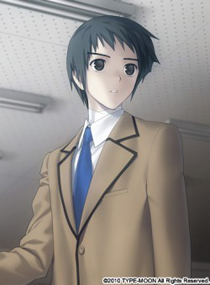 Shizuki Soujuro (静希草十郎)
Shizuki Soujuro (静希草十郎)
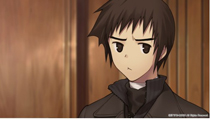
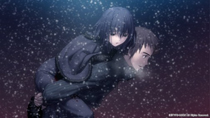
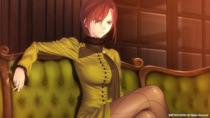 Aozaki Touko (蒼崎橙子)
Aozaki Touko (蒼崎橙子)
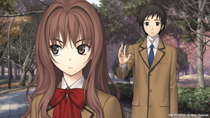 Kumari Kojika (久万里金鹿)
Kumari Kojika (久万里金鹿)
—"Tsukuri magic" — 「Mahoyo」's unique production
4Gamer:
Speaking of which, I have some questions for the person in charge of production, Tsukuri-san. As we mentioned before, this work is supported by its high-level production. In the very beginning, what did you have in mind when you first took up 「Mahoyo」?
Tsukuri:
It wasn't as big a project in the beginning. I thought of creating something similar to illustrations in a novel, without too many illustrations. Once development actually began, it became impossible to properly show 「Mahoyo」's world with existing production techniques. An enjoyable play experience was still possible, but it wouldn't be something appealing to the soul when finished. Ending with a whimper.
4Gamer:
「Mahoyo」 is different from 「Fate」, almost all events in the script are done from a third-person point of view. I feel this in itself is a very big difference.
Nasu:
The original script from the novel was written in the third-person point of view, and the content was fairly simple as well. It's mainly to capture Aoko, Alice, and Soujuro's daily lives, for the purpose of "objective observation," I wanted to use the third-person point of view. However, in reality it's very difficult to write a visual novel in the third-person. If I wrote in the third-person using current galgame's or visual novel's structure, there would be holes in the graphics and production. Tsukuri Monoji's directing solved this problem perfectly.
4Gamer:
When you say the structure of current visual novels, you mean the method where characters' portraits are placed on top of background CG facing the player as they speak, and when the action picks up, special event CG's are used? In 「Mahoyo」, there is no longer a difference between portraits and event CG.
Nasu:
There are almost no event CG's in 「Mahoyo」. The ones players think are event CG are actually put together from portraits.
4Gamer:
How many CG's are there?
Koyoma:
Probably not even 200. If you only count the ones where characters are present, there really aren't that many. A lot of materials are made where Tsukuri cuts and pastes after figuring out how to produce a scene, we don't have an exact number.
Tsukuri:
Up until now it has always been like a FPS, so this time I wanted to make it in a way that matches Nasu's third-person point of view, instead of directing it in first-person. Putting portraits on top of backgrounds has always been the method used, even when there are 2 characters, they face the player instead of facing each other. Even then, they go on as if the player doesn't exist, having a conversation with each other while looking this way.
4Gamer:
In a way, this is the "promised way" of visual novel.
Tsukuri:
Right. While producing 「Mahoyo」, I was able to feel the inconsistency of this presentation method, so I did my best to not use it. I feel that kind of "promised way" has already become an obstacle to a player when he or she is trying to experience and understand a game.
4Gamer:
Actually during for this interview, aside from Nasu and Koyoma, I also wanted to hear Tsukuri-san's opinion on this. Speaking of which, an event in 「Fate/hollow ataraxia」 left a deep impression on me, the battle between Saber and Archer at the Fuyuki Bridge. That scene was produced by Tsukuri-san right?
Tsukuri:
Thank you, yes that's me.
4Gamer:
I was tremendously shocked when I saw that scene, on the level of "this has surpassed all common expectations in a conventional visual novel" ...at the time, I really felt it was something that cannot be surpassed.
Nasu:
For the production of that scene, Tsukuri first made the storyboard, and then we added content around it. In terms of production, Fate is already a good as it gets, so when it comes to scenes in 「Fate/hollow ataraxia」, one of the challenges is to create something new.
4Gamer:
Ah about that, I played it many times over, so I'm really happy Tsukuri-san could make it today. Since then, I've always felt more critique should be focused on a visual novel's production.
Tsukuri:
I'm very happy to hear you say this. However, in 「Mahoyo」's case, most of my resources are from the first-person point of view, and it would have been impossible to convert them all to the third-person. In the end, I decided to challenge myself by creating third-person scenes using the first-person resources... if things didn't turn out like this, 「Mahoyo」 probably would have been released a year ago, I'm so sorry!
Nasu:
Allow me to re-emphasis the impressiveness of the feat that Tsukuri-san managed to accomplish. When he says first-person resource, he means materials created using methodologies used all the way up to 「Fate」. So with Shirou Emiya as the protagonist, all materials were created based on his point of view. So in effect, there only existed artworks from the main protagonist's point of view.
Koyoma:
This includes portraits and backgrounds, all materials were drawn in accordance with the conventional "promised way" of visual novels. Being able to create a scene with the effect of a camera moving around without extra drawings of views from above or below, it gives you an "Eh~~ Like this!" feeling. Cutting up a finished drawing and recreating it freely is a ridiculously scary technique.
Nasu:
That's the "Tsukuri magic."
4Gamer:
Ah, calling it magic is perfect, what kind of work went into that kind of production? Did you make the storyboards beforehand, or did you put together the graphics like a puzzple during production?
Tsukuri:
It's mostly the latter, storyboards were drawn for some important scenes. Scenes like everyday conversation were made in an explorative process during production, like "if I do it like this, these will tie together really well." Doing every single waypoint markers by hand would have wasted too much time, so I asked our programmer Seibei to make a dedicated production editor. In this way I was able to focus all my attention on pure production, so if you want to call it magic you should call it Seibei magic.
4Gamer:
It seems the layout process from animation is used in all everyday event scenes. At least for this work, I think the phenomenon of "2 characters talking to each other while facing the front" that was mentioned earlier doesn't exist.
Tsukuri:
Yup, after playing you'll feel scenes with a lot of movement are more attractive. During production, the part that took the most time was using my existing resources to create layouts. Of course we also focused a lot on battle scenes, but I hope to pass the feelings we put into the everyday scenes to the player as well.
4Gamer:
In other words you can no longer accept the "promised way" of conventional visual novels? When did you make this realization?
Tsukuri:
En... I used to work like "this mark goes here" as well... but while working on 「Mahoyo」, I was very concerned about this from the beginning.
Nasu:
It's probably due to a difference in perspective. For example, players will probably accept anything from an ADV. Relying on the "promised way," you can create story at a fairly low cost. However, there are people who, being able to slowly understand that, and being a producer, cannot accept it, actually Tsukuri Monoji is a prime example of that.
Tsukuri:
Aside from the story being in the third-person, another big reason is the quality of the backgrounds and character portraits are on a totally different level compared to the ones I've worked with before. With 「Fate」 I still used markers, but I felt such deep dimension and depth from 「Mahoyo」's graphics, I had to make them come alive. I originally just wanted to combine the backgrounds and character portraits without any inconsistency, but the more I mixed them, the closer I felt to that "conventional promised way." In the end, I thought "wouldn't it be more fun to just produce everything with camera angle techniques."
4Gamer:
So is Tsukuri satisfied with how 「Mahoyo」 turned out? What do you think about it? ...to tell the truth, I think it can be further improved, especially the everyday scenes.
Tsukuri:
Ah, sorry, you are right. I feel a lot of places "lack coordination." I will do my best to fill them in next time.
Nasu:
I just hope Tsukuri-san can relaxed a bit before he breaks down (laughs).
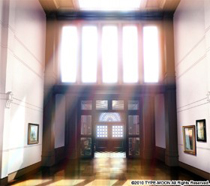
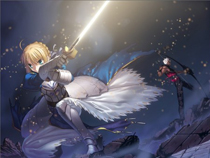 A decisive battle from 「Fate/hollow ataraxia」, a battle between Saber and Archer that did not happen in 「Fate/stay night」. One of the best scenes found in TYPE-MOON's work.
A decisive battle from 「Fate/hollow ataraxia」, a battle between Saber and Archer that did not happen in 「Fate/stay night」. One of the best scenes found in TYPE-MOON's work.
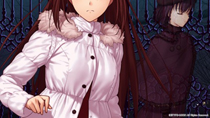
—The truth behind "Tsukuri Magic" [The Japanese Robin's Takeoff]
Throughout the text we've been talking about "Tsukuri Magic," and here we have picked out a few from the game to discuss.
First, below is a crop from the scene where the Japanese Robin is flying toward and then away from Alice. Only the two Robin images to the left were used in this scene, with the actual movements programmed in, and movement blurs applied through programming. The part where it momentarily stops and hovers in the air, the opacity on the images is cycled and the position moved up and down to give a realistic appearance. It wouldn't be too much to say this came out as a testament to Tsukuri-san's devotion and obsession. The technique he discovered here was later put to use in battle scenes, taking into account feedbacks from others.
We had originally prepared lines for the Robin that only chirped "pi pi pi" in the first half of the story. Even during the middle of development, there was an option with a "Robin Switch" to turn on and off its dialogue. However, his dialogue made a mess of the romance scenes, so with tears we took out this part from the game.
According to Nasu, Tsukuri himself became the model for the Robin's dialogue. Tsukuri love birds, and many characters were completed with inputs from Tsukuri and Nasu.
—Battle at the abandoned amusement park — a wild and exhilarating performance
4Gamer:
As clues to understanding Tsukuri's techniques, I'd like to hear about the works that have had an impact on Tsukuri.
Tsukuri:
...there's none this time, especially for this project. If you really insist, it would have to be films and television, or scenery from nature, stuff that I've witnessed since I was little. For example, the Aoko's entrance or the movements of the golem, the scene in 「Thunderbird 2」 where the Elevator Cars were dropped was used as reference... perhaps.
Nasu:
This is the first time I've heard this.
Tsukuri:
As for things I'm actively aware of that recently had an impact on me, something like 「Evangelion: 1.0 You Are (Not) Alone」. I had a different mindset than when working on 「Fate」, meaning I was able to present a more immersive experience. For example, if for 「Fate」 I thought of "how to best present the sword swing" during a scene where Saber swings her sword, then for 「Mahoyo」 I would think of "before the swing, if the sword was swung, what would the surroundings be like." It's the same for 「Eva」, it's not only about shooting, but also all those electrical facilities and machineries are equally striking.
4Gamer:
Ahh, nothing better than Operation Yashima. I can understand that very well. So yes, Aoko is Ramiel... by the way, what is Tsukuri's impression of Aoko and Alice?
Tsukuri:
Since during development I only thought of things like how to make the parts more flexible or fluid, seeing them as characters came after the master up. Looking back at the scene in the amusement park where Aoko beats up Soujuro, I'd think to myself: "Ah, even though there are parts I misunderstood, Aoko really does seem more like the female protagonist."
Nasu:
That's what I've been saying, give up on things like lasers. There is no meaning in heroines using things like lasers, it's not possible.
Tsukuri:
Right, that's impossible. Because, she never shoots any lasers beam in the original story!
Nasu:
But the amusement park scene never appeared in the original work. Battles before they began living together concluded at the puppet battle.
4Gamer:
Hey hey, but in terms of flashiness, the incident at the amusement park is probably the top one in 「Mahoyo」...
Nasu:
This duck... no, man known as Tsukuri Monoji is the main culprit. The doll battle in the original work took place in the school, "we already did that in 「Fate」, let's choose a different place." However, if we choose a complex location, the terrain material will become troublesome. So what's a stage that's easy to do, but also gives off a good atmosphere... while stumped by this, suddenly Tsukuri came up with "how about an abandoned amusement park." Wouldn't that result in very hard work!? While at the same time mumbling "really want to do... abandoned amusement park (drool)."
Tsukuri:
Even though that's what I thought, didn't a lot of people like the idea of an abandoned amusement park? The feeling of being pursued by an unknown entity, combined with the unique mood of ruins, don't you think that's wonderful? But I do want to say, when we thought of this, 「Mahoyo」 was still a very small project. Later the project became bigger and bigger as we added stuff here and there, and after that came all the effort of developing it in the third-person view. In the end, it turned into feelings such as "Ruins!? But we don't have any pictures of it! That script writer!!"
4Gamer:
In other words the Flat Snark battle wasn't originally planned?
Nasu:
Right. While other parts were developed according to the original novel, the amusement park ruins and things from the extra stories were all done with Nasu's writing style from 2009 ...even though I didn't want Alice to show her true skills that early. After organizing the ideas of the amusement park battle, I was confident that doing the scene like this would make it really fun, so we had to go ahead with it (laughs). Although we original said we won't forcefully add in elements to please the players, something like this would probably be required for the amusement park battle. Later, Koyoma even said he wanted to put in laser beams.
Koyoma:
Eh, I did? ...is that true?
Nasu:
This was around the time when 「Evangelion: 1.0 You Are (Not) Alone」 was announced. Didn't you say you want to include awesome things like laser beams.
Tsukuri:
There is a slight difference. Koyoma did say he want to do something awesome, but weren't you the person who accepted that and decided to put in laser beams? You are the guilty one!
Nasu:
R-really... but, but, Aoko is a be-ma anyways. Also, it was you who turned a regular beam into a spraying Wave Motion Gun! I was really shocked when I saw the end product! "This turned into a scene I've never seen before" (laughs).
Tsukuri:
About that, that's true... but haven't you heard of stuff like 3.5 shots? Why can we shoot the exact same beam three times!?
4Gamer:
In other words the amusement park scene came from a merger of each of your ideas (laughs).
Nasu:
In reality the development of 「Mahoyo」 consists of cycles of someone raising the bar, which in turn lights up the spirits of everyone else. The sudden burst from Tsukuri was part of that cycle. The result was something along the lines of "Monoji's body won't be able to take it!"
Koyoma:
It's the same with Aoko shooting those beams, in the original design there were 4. As proof, the image in the gallery only has 4 beams. But in reality, when we took apart that image, somehow we ended up with 8 beams... I was shocked when I first saw it (laughs).
Nasu:
Same with the lines in the magic circle. But no one can say anything after seeing that quality. On my side, I can only respond by changing the script.
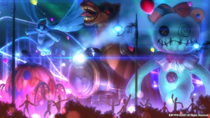
—The truth behind "Tsukuri Magic" [Aoko's Beam, the Transformation of the Second Shot]
I was unaware that Aoko's beam turned into 8 shots of spraying Wave Motion Gun, however, according to Tsukuri, because this first shot of the act became flashier than expected, improvements to other parts became necessary.
The upper part of the image is the arrangement from the original production plan. As mentioned in the text, 4 beams are shot. The final production lies below, standing in contrast to the first shot as looking high-powered, unlikely to die off any time soon. The beams are also greater in number, expressing intensity and presence and pulling everything together, from the spectacle itself to scenery beyond. "Even if just a little, I hope it makes you think of Aoko," says Tsukuri-san
4Gamer:
Probably the amusement park battle is more difficult than the final battle between Aoko and Touko in terms of production. Although, the changing of the four seasons when Aoko's magic activated gave me chills.
Tsukuri:
And we produced that 2 years ago.
Nasu:
The changing of the four seasons was used to show the world has been changed. Please enjoy the unreal work of our background art team, producing this kind of result for a scene that only lasts a minute... but, that particular scene was done quite a while ago, and seems to be one of the scenes Tsukuri most want to redo. In the end, we worked on Ploy-Kickshaw instead of that scene.
4Gamer:
For that scene, you've even paid attention to adjusting the timing and volume of the BGM and SE.
Nasu:
In fact, of things we worked really hard on, Tsukuri also managed the music and SE. If we were to redo the production, I think the Touko battle would probably be something totally different as well. In terms of battle scene quality, the amusement park battle is probably the best because it was done last. Looks like the amusement park scene really is the peak of our production.
Tsukuri:
We reached the final stage of production as the script editor mentioned earlier and the technology matured. While finishing up production tasks, I also responded to feedbacks such as "Ah I want to make this more exciting" and "let's fix this bug."
Nasu:
That's because there were a lot of things we wanted to do in the beginning but couldn't... let me give you some shocking information. We originally only prepared one normal background art for the amusement park scene. As for the mirror house from the first half of Chapter 5, that scene didn't even have any background arts. The effect of mirror house was created by cutting and pasting the art of "while running, Aoko's feet were reflected on one of the walls."
Tsukuri:
Heh, instead of saying we eagerly went and did it, it's more appropriate to call it using existing resources to the fullest (laughs).
Nasu:
Ah that's really something though? Everyone is commenting on how the amusement park scene from the second half of Chapter 5 is so great, which is correct. But if the second half of Chapter 5 was done with Monoji's feel, then the first half was done when Monoji's madness erupted. I believe in 「Mahoyo」 the mirror house scene is the one that accomplished "turning what doesn't exist into something that exists."
4Gamer:
That scene, was it like that in the original script?
Nasu:
That's right. To tell you the truth, when I worked on the script, I thought "the presentation of this part, it probably can't be achieved" ... (side glares from Tsukuri) Ah, not unachievable, how could an author make such reckless designation.
Tsukuri:
...
Nasu:
I'm sorry, in my mind the mirror house scene can only be done like in a regular visual novel, pointing the camera to the sky, then display some text and that's it. But Tsukuri Monoji did not run away from it. As a result, the mirror house part as a scene surprised even me, the script writer.
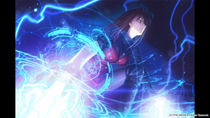
—The truth behind "Tsukuri Magic" [The Mirror House Battle]
How was the mirror house scene created without any existing background material? Let me explain while looking at the script editor.
The image on the left is the completed version of the scene, the one on the right is the components that make up the scene, it's easier like this to understand how each piece is displayed. Pieces 1 to 4 are the reflected backgrounds that make up the image, pieced together from copy-pasted materials. Piece 1 is a broken mirror background, piece 2 is a image of Aoko running, piece 3 is the doll up close, each piece is cut up and made useful in multiple places. Also, piece 4 uses the same material as piece 1, with a different hue added on top.
Furthermore, the pole from piece 5 to 7 were taken from the background of the aquarium scene. In order to present seams of the mirrors in piece 8 to 13, thin lines of black and white are programmed in directly in the program. Finally, on top of the previous background materials, I add the image of Aoko standing, and by adjusting the brightness, contrast, transparency, scale, and layering, we end up with the final scene you see in the game.
—TYPE-MOON's reason to continue to develop visual novel games
4Gamer:
From now let's talk about 「Mahoyo」 as a whole, especially regarding its commitment as a visual novel. Today TYPE-MOON works on a large range of products, from novel to anime. Despite this, you still dedicate yourself to visual novel, and have created a game like this, what's the reason behind it?
Nasu:
In the end it looks like I'm still someone who likes ADV games from around 2004. If I had to say which part was the most interesting, wasn't it because people rose up to make them yelling "let's make something fun" during a time when anime was the king of entertainment? Today, since most works need to be prepared to be adapted into anime, they are written with anime in mind.
4Gamer:
True, between the latter part of the 1990s and the beginning of 2000, compared to anime, visual novels and light novels are placed high in the "Otaku Culture." Anime was stronger both before and after that, even though today's situation is still somewhat unbelievable.
Nasu:
Correct, I'm not happy with the content of works that exist in this area. Things like games and novels feel like an intermediate product on their way to becoming anime. I want to create a world where I can proudly say "It shouldn't be like this, this here is also a final product." I will pursue this goal even if it means to continually make works that are fun to play. Not "something else's replacement," I want to challenge things that are "only achievable as ADV."
4Gamer:
Like Nasu said before, the goal is to raise the overall bar for visual novels, this is something I clearly felt while playing. Looking at 「Mahoyo」, the feeling of "this really is a finished product" is strong.
Nasu:
Of course, I'd be very happy as well if it's adapted to another media in the future. If this happened to 「Mahoyo」 it would be great, but despite this, I wanted to create a perfect work first. After 「Mahoyo」 was released, another creator in the field said to me: "this is the first time I've played a work that has ignored multimedia. Even though I've heard so many times others screaming it's impossible to animate, the truth is there is no need to animate it in the first place." I feel saved when hearing that. 「Mahoyo」 is worth this much even though it's going against the current trend, I was very relieved.
4Gamer:
About the Saber vs. Archer battle from 「Fate/hollow ataraxia」 mentioned earlier, while playing that scene, I felt the potential of the visual novel medium. Neither anime nor novels can achieve that kind of presentation.
Nasu:
If it's a scripter, then that should be possible, since that's similar to an anime director.
4Gamer:
In my personal opinion, visual novel is something that is able to, on the foundation of telling a story, miraculously strike a balance between production cost (manpower) and expressive power. While an anime has high expressive power, its cost is also high, and a novel has low expressive power as well as low cost. Visual novel is somewhere between the two, also, there are things that cannot be communicated without this format.
Nasu:
What you say makes sense, aside from cost, there's also time, so it's fairly complicated. In the current situation there's too much pressure on the script writer. In anime it feels like the scripter is doing the work of scenes usually done by a 100 people, although in this case even by adding more people, it won't be the same as including Tsukuri. In the end we can only let Tsukuri work on it little by little. Ahh, it's just like when Shinkai Makoto-sensei produced anime by himself.
4Gamer:
Ah I see. To ensure quality, even Shinkai had to commercialize his work to bring in more manpower. While I want to see more visual novel produced by Tsukuri, now looks like it's not that simple... Let's talk about something other than production, choices during gameplay. I feel the way the game has no branching routes or voice strays from the current trend.
Nasu:
Regarding player choices, I was fairly anxious. Despite that, to create a work with special story and atmosphere, I gave up on choices because I want the players to better experience it.
If the garden known as 「Mahoyo」 is damaged by adding too many gameplay elements, then those elements need to be removed. On the other hand, as a game, I wanted to add some small tricks not possible for paper novels. More precisely, the bookshelf from the Archive—even though that's Aoko's bookshelf, the way it slowly fills up is a trick paper medium cannot achieve.
4Gamer:
Branching routes was never considered since the beginning?
Nasu:
No, it was there in the beginning. Soujuro's replies contained choices that affected his appeal to the female characters, Aoko's choices would change destiny itself, something like that. As to why we did this, I'm sure those who have played the game will understand.
4Gamer:
While talking to Urobuchi Gen earlier, he said "the story is easier to write without choices" and "I'm not suited to write stories with branching routes," what about Nasu?
Nasu:
Of course I won't deny the existence of choices. For example in 「Fate」, if you made the wrong choice, you die, which shows the world's changing destiny. So I feel it's okay for choices to appear as a meaningful part of the game. It just wasn't appropriate for 「Mahoyo」 this time.
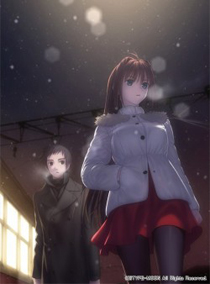
 From the Archive, Aoko's bookshelf.
From the Archive, Aoko's bookshelf.
—Mahoutsukai no Yoru, from now onwards
4Gamer:
So in the end, I hope to hear TYPE-MOON's plan for the future. Especially regarding the development of 「Mahoyo」, I'm certain a lot of fans are interested as well...
Tsukuri:
According to rumors, it seems there will be a 2 and 3.
Nasu:
Th-that, a written proposal like that does exist! ...Ah, I'm very sorry. 「Mahoyo」's story has come to an end for now, but the story on that street that centers around the lives of those three is still going. Just like after 「Jukkaku-kan no Satsujin」 there is 「Suisha-kan no Satsujin」. I think there will be a total of 3 games. In the end, Aoko, Soujuro, and Alice's future will be clearly shown ...Of course we don't want the players to continue waiting like this, so hopefully the release time for the 2nd and 3rd part will be shorter. The real story will begin in the 2nd part.
4Gamer:
Oh oh, so there will be sequels!
Nasu:
There will be sequels. Although the first part has concluded as a young adult work, there are places in there that made people go "?". Because we spread some very subtle hints, most readers will likely think "it's probably because of this." I think when the answers are revealed, it'll bring you the highest level of catharsis... in this regard I can only ask you to wait for the 3rd part.
4Gamer:
If that's the case, then the big question is when they will be released...
Nasu:
Because we have already figured out how to more efficiently work on production, which took the most time this time around, the time should be much shorter. The pressure on director Tsukuri Monoji should be much lighter.
Koyoma:
Looking back, we did many unnecessary things during development this time. Many materials were also created through trial and error. This time with a clear goal and method, we should be able to work more efficiently.
4Gamer:
In other words, waiting for many years... that won't happen again?
Tsukuri:
If I have the script, I can start work tomorrow (glances).
Nasu:
Who wants to clone another me? Works that have stopped development until 「Mahoyo」's release are piling up like an avalanche...
4Gamer:
Realistically speaking, for the quality to be higher than the first game, we should all be able to wait 1, no, 2 years is still reasonable...?
Nasu:
Thank you very much! Today, I have felt this world's warmth.
Tsukuri:
Nope, there's no way we can wait for you.
Nasu:
Monojiiiiii! ...Eh, I'm very sorry. I will make sure the quality is on another level, and do my best working towards the best story. Really, it would be great if everyone can wait for me with anticipation.
4Gamer:
It's particularly interesting that there will be sequels, the reason Aoko was chosen to inherit the Aozaki family's heritage over Touko was not clearly states in the first game, is this something that will be explained in later works?
Nasu:
There are hints spread throughout the story, people with good intuition should have already noticed. Aoko's magic circuit itself is a hint. Even though Touko's magic circuit is one of the best in the world, Aozaki's fifth magic does not require that kind of thing. Rather, Aoko's pureness is more suitable, something like that.
4Gamer:
Regarding the fifth magic itself, there are still many secrets.
Nasu:
I'm sure everyone is interested in that part... sorry, but the explanation for that will come in the future. This is also related to the "advancing civilization" we talked about earlier...
4Gamer:
Soujuro, who came from the forest and gradually became weaker as he made contact with civilization, and Aoko who is watching him, something like that?
Nasu:
This was already mentioned in the game. Alice represents Medieval Civilization, while Aoko represents Consumption Civilization. The reason why Aoko is called the "newest" magician, the answer to this is also found in the fifth magic.
4Gamer:
Ah... so that's why. I understand now. So what about things other than 「Mahoyo」?
Nasu:
Regarding TYPE-MOON's works, first is to release the delayed 「Fate/EXTRA CCC」. I'm so sorry about the delay! However, we worked hard to make it into a flavorful game where people would say after playing "niche game isn't too bad," please look forward to it.
Although I can't give any details, the long awaited 「Tsukihime Remake」 is also being worked on in parallel.
4Gamer:
Let me ask something that interests me personally, how about 「DDD」...
Nasu:
Uuugh (sweat)... I would like to sincerely thank the readers who have waited patiently. I can already see the ending for that, after I finish 「Mahoyo」...
4Gamer:
Understood. In the end, can Koyoma and Tsukuri please say a few final words.
Koyoma:
「Mahoyo」 is my first work as art director, and I have some special feelings toward it. So, I will also work hard on 2 and 3, and turn in satisfactory results.
Tsukuri:
This time I realized I'm a person who not only cares about outside reviews, but also someone who wishes to create things that he himself is satisfied with. Regarding 「Mahoyo」, the first part was created in this way, I will also take up the responsibility and work till the end for the sequels. The development process is also better now, so hopefully they will be released soon.
4Gamer:
As I played the first part, I was shown the next level of visual novels, I hope the ones that come after it will continue to raise the bar of the entire genre. Thank you for today.
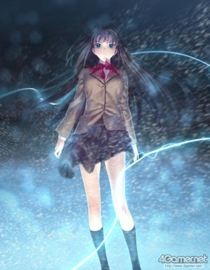
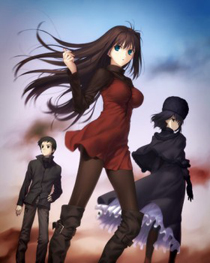
—Recorded on 2012-04-20









